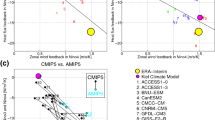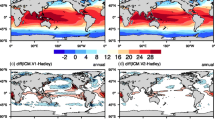Abstract
A long-standing difficulty of climate models is to capture the annual cycle (AC) of eastern equatorial Pacific (EEP) sea surface temperature (SST). In this study, we first examine the EEP SST AC in a set of integrations of the coupled Kiel Climate Model, in which only atmosphere model resolution differs. When employing coarse horizontal and vertical atmospheric resolution, significant biases in the EEP SST AC are observed. These are reflected in an erroneous timing of the cold tongue’s onset and termination as well as in an underestimation of the boreal spring warming amplitude. A large portion of these biases are linked to a wrong simulation of zonal surface winds, which can be traced back to precipitation biases on both sides of the equator and an erroneous low-level atmospheric circulation over land. Part of the SST biases also is related to shortwave radiation biases related to cloud cover biases. Both wind and cloud cover biases are inherent to the atmospheric component, as shown by companion uncoupled atmosphere model integrations forced by observed SSTs. Enhancing atmosphere model resolution, horizontal and vertical, markedly reduces zonal wind and cloud cover biases in coupled as well as uncoupled mode and generally improves simulation of the EEP SST AC. Enhanced atmospheric resolution reduces convection biases and improves simulation of surface winds over land. Analysis of a subset of models from the Coupled Model Intercomparison Project phase 5 (CMIP5) reveals that in these models, very similar mechanisms are at work in driving EEP SST AC biases.















Similar content being viewed by others
References
Carton JA, Giese BS (2008) A reanalysis of ocean climate using simple ocean data assimilation (SODA). Mon Weather Rev 136:2999–3017. https://doi.org/10.1175/2007MWR1978.1
Chen Y-Y, Jin F-F (2017) Dynamical diagnostics of the SST annual cycle in the eastern equatorial Pacific: Part II analysis of CMIP5 simulations. Clim Dyn. https://doi.org/10.1007/s00382-017-3550-z
Covey C, Abe-Ouchi A, Boer GJ et al (2000) The seasonal cycle in coupled ocean–atmosphere general circulation models. Clim Dyn 16:775–787. https://doi.org/10.1007/s003820000081
de Szoeke SP, Xie S-P (2008) The tropical eastern pacific seasonal cycle: assessment of errors and mechanisms in IPCC AR4 coupled ocean–atmosphere general circulation models*. J Clim 21:2573–2590. https://doi.org/10.1175/2007JCLI1975.1
Dee DP, Uppala SM, Simmons AJ et al (2011) The ERA-Interim reanalysis: configuration and performance of the data assimilation system. Q J R Meteorol Soc 137:553–597. https://doi.org/10.1002/qj.828
DeWitt DG, Schneider EK (1999) The processes determining the annual cycle of equatorial sea surface temperature: a coupled general circulation model perspective. Mon Weather Rev 127:381–395. https://doi.org/10.1175/1520-0493(1999)127<0381:TPDTAC>2.0.CO;2
Giese BS, Carton JA (1994) The seasonal cycle in a coupled ocean–atmosphere model. J Clim 7:1208–1217
Harlaß J, Latif M, Park W (2015) Improving climate model simulation of tropical Atlantic sea surface temperature: the importance of enhanced vertical atmosphere model resolution. Geophys Res Lett 42:2401–2408. https://doi.org/10.1002/2015GL063310
Harlaß J, Latif M, Park W (2017) Alleviating tropical Atlantic sector biases in the Kiel climate model by enhancing horizontal and vertical atmosphere model resolution: climatology and interannual variability. Clim Dyn. https://doi.org/10.1007/s00382-017-3760-4
Kessler WS, McPhaden MJ, Weickmann KM (1995) Forcing of intraseasonal Kelvin waves in the equatorial Pacific. J Geophys Res 100:10613. https://doi.org/10.1029/95JC00382
Latif M, Graham NE (1992) How much predictive skill is contained in the thermal structure of an oceanic GCM? J Phys Oceanogr 22:951–962
Latif M, Sperber K, Arblaster J et al (2001) ENSIP: the El Niño simulation intercomparison project. Clim Dyn 18:255–276. https://doi.org/10.1007/s003820100174
Lin JL (2007) The double-ITCZ problem in IPCC AR4 coupled GCMs: ocean–atmosphere feedback analysis. J Clim 20:4497–4525. https://doi.org/10.1175/JCLI4272.1
Ma C-C, Mechoso CR, Robertson AW, Arakawa A (1996) Peruvian stratus clouds and the tropical pacific circulation: a coupled ocean–atmosphere GCM study. J Clim 9:1635–1645. https://doi.org/10.1175/1520-0442(1996)009<1635:PSCATT>2.0.CO;2
Madec G, Delecluse P, Imbard M, Lévy C (1998) OPA 8.1 ocean general circulation model reference manual. Note du Pole de modélisation 11, Institut Pierre-Simon Laplace, 91 pp
Mechoso CR, Robertson AW, Barth N et al (1995) The Seasonal cycle over the tropical pacific in coupled ocean–atmosphere general circulation models. Mon Weather Rev 123:2825–2838
Mitchell TP, Wallace JM (1992) The annual cycle in equatorial convection and sea surface temperature. J Clim 5:1140–1156. https://doi.org/10.1175/1520-0442(1992)005<1140:TACIEC>2.0.CO;2
Moum JN, Perlin A, Nash JD, McPhaden MJ (2013) Seasonal sea surface cooling in the equatorial Pacific cold tongue controlled by ocean mixing. Nature 500:64–67. https://doi.org/10.1038/nature12363
Neelin JD (1991) The slow sea surface temperature mode and the fast-wave limit: analytic theory for tropical interannual oscillations and experiments in a hybrid coupled model. J Atmos Sci 48:584–606. https://doi.org/10.1175/1520-0469(1991)048<0584:TSSSTM>2.0.CO;2
Park W, Keenlyside N, Latif M et al (2009) Tropical Pacific climate and its response to global warming in the Kiel climate model. J Clim 22:71–92. https://doi.org/10.1175/2008JCLI2261.1
Philander SGH, Gu D, Lambert G, et al (1996) Why the ITCZ is mostly north of the equator. J Clim 9:2958–2972. https://doi.org/10.1175/1520-0442(1996)009<2958:WTIIMN>2.0.CO;2
Reynolds RW, Rayner NA, Smith TM, et al (2002) An improved in situ and satellite SST analysis for climate. J Clim 15:1609–1625. https://doi.org/10.1175/1520-0442(2002)015<1609:AIISAS>2.0.CO;2
Roeckner E, Baeuml G, Bonaventura L et al (2003) The atmospheric general circulation model ECHAM 5. PART I: model description. Max Planck Inst Meteorol Rep 349:127
Song ZY, Liu HL, Wang CZ et al (2014) Evaluation of the eastern equatorial Pacific SST seasonal cycle in CMIP5 models. Ocean Sci 10:837–843. https://doi.org/10.5194/os-10-837-2014
Stein K, Timmermann A, Schneider N (2011) Phase Synchronization of the El Niño-Southern Oscillation with the Annual Cycle. Phys Rev Lett 107:128501. https://doi.org/10.1103/PhysRevLett.107.128501
Stockdale T, Latif M, Burgers G, Wolff J-O (1994) Some sensitivities of a coupled ocean–atmosphere GCM. Tellus A Dyn Meteorol Oceanogr 46:367–380. https://doi.org/10.3402/tellusa.v46i4.15486
Taylor KE, Williamson D, Zwiers F (2000) The Sea surface temperature and sea–ice concentration boundary conditions for AMIP II simulations. Lawrence Livermore National Laboratory PCMDI Rep. 60, p 28
Taylor KE, Stouffer RJ, Meehl GA (2012) An overview of CMIP5 and the experiment design. Bull Am Meteorol Soc 93:485–498. https://doi.org/10.1175/BAMS-D-11-00094.1
Valcke S (2006) OASIS3 user guide. PRISM Tech Rep No 3:64
Wentz FJ, Scott J, Hoffman R, Leidner M, Atlas R, Ardizzone J (2015) Remote sensing systems cross-calibrated multi-platform (CCMP) 6-hourly ocean vector wind analysis product on 0.25 deg grid, Version 2.0. Remote Sensing Systems, Santa Rosa, CA. www.remss.com/measurements/ccmp. Accessed Feb 2016
Xie S-P (1994) On the genesis of the equatorial annual cycle. J Clim 7:2008–2013
Xie S-P (2005) The shape of continents, air–sea interaction, and the rising branch of the Hadley circulation. In: Diaz HF, Bradley RS (eds) The Hadley circulation: past, present and future, vol 21, advances in global change research. Springer Netherlands, Dordrecht, pp 121–152. https://doi.org/10.1007/978-1-4020-2944-8_5
Xie P, Arkin PA (1997) Global precipitation: a 17-year monthly analysis based on gauge observations, satellite estimates, and numerical model outputs. Bull Am Meteorol Soc 78:2539–2558. https://doi.org/10.1175/1520-0477(1997)078<2539:GPAYMA>2.0.CO;2
Xie S-P, Miyama T, Wang Y et al (2007) A regional ocean–atmosphere model for eastern Pacific climate: toward reducing tropical biases. J Clim 20:1504–1522. https://doi.org/10.1175/JCLI4080.1
Yu J-Y, Mechoso CR (1999a) A discussion on the errors in the surface heat fluxes simulated by a coupled GCM. J Clim 12:416–426
Yu J-Y, Mechoso CR (1999b) Links between annual variations of Peruvian stratus clouds and of SST in the eastern equatorial Pacific. J Clim 23:305–318
Yu L, Weller RA (2007) Objectively analyzed air–sea heat fluxes for the global ice-free oceans (1981–2005). Bull Am Meteorol Soc 88:527–539. https://doi.org/10.1175/BAMS-88-4-527
Yu Y, He J, Zheng W, Luan Y (2013) Annual cycle and interannual variability in the tropical pacific as simulated by three versions of FGOALS. Adv Atmos Sci 30:621–637. https://doi.org/10.1007/s00376-013-2184-2
Acknowledgements
This work was supported by the German Ministry of Education and Research (BMBF) grant SACUS (03G0837A) and EU FP7/2007–2013 under Grant agreement no. 603521, project PREFACE, and SFB 754 “Climate-Biochemistry Interactions in the tropical Ocean”. We thank two anonymous reviewers for helpful comments and feedbacks on this work. The climate model integrations were performed at the Computing Centre of Kiel University. We acknowledge the World Climate Research Programme’s Working Group on Coupled Modelling, which is responsible for CMIP, and we thank the climate modeling groups (listed in Table 2 of this paper) for producing and making available their model output. For CMIP the U.S. Department of Energy’s Program for Climate Model Diagnosis and Intercomparison provides coordinating support and led development of software infrastructure in partnership with the Global Organization for Earth System Science Portals.
Author information
Authors and Affiliations
Corresponding author
Electronic supplementary material
Below is the link to the electronic supplementary material.
Rights and permissions
About this article
Cite this article
Wengel, C., Latif, M., Park, W. et al. Eastern equatorial Pacific sea surface temperature annual cycle in the Kiel Climate Model: simulation benefits from enhancing atmospheric resolution. Clim Dyn 52, 1983–2003 (2019). https://doi.org/10.1007/s00382-018-4233-0
Received:
Accepted:
Published:
Issue Date:
DOI: https://doi.org/10.1007/s00382-018-4233-0




